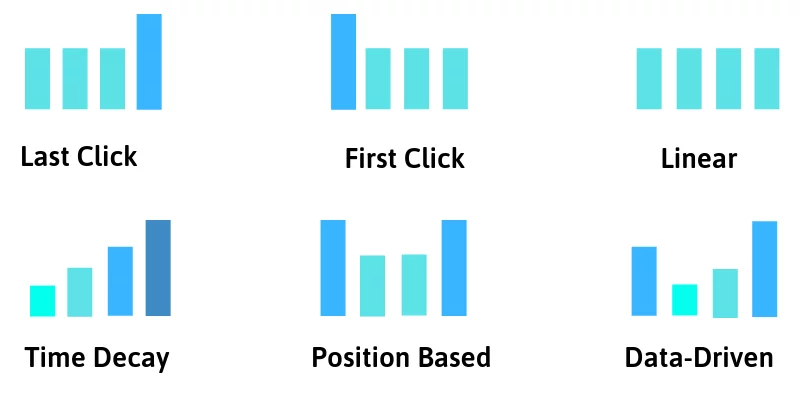Google Ads formerly known as Google AdWords, is an advertising platform introduced by Google in October 2000.
It is a platform where advertisers promote their different kinds of products, service offerings within the Google network to the users. It is a paid form of advertising which offers services under a pay-per-click (PPC) model.
Brief on Google Attribution Model
Attribution models give a better understanding of how the ads perform. With the help of this model, the advertisers can measure the visibility and success of the ads.
When a customer interacts with various ads by the advertiser, the attribution model shows how much credit each click needs to give for the conversions.
The attribution model helps the advertiser to reach the customer in the earlier phase of the purchase cycle and improve the bidding by optimizing the performance of the ads.
6 Types of Attribution Models:
This attribution model is the most commonly used model, and as the name implies this model gives credit to the last interaction the click which leads to sale or conversion by the ad.
Last click attribution helps marketers to detect which CTA is the most effective for convincing the customers to purchase the product or services. It is simplest to implement and evaluate.
For Example: If a person finds your website by an organic search and the next day he finds an ad for your site on any search engine or social media platform and clicked on it and after that, he directly goes to the website and makes the purchase.
In this case, the credit will be given to the last interaction made after which the purchase is complete.
It is similar to last-click attribution in the sense that even this employs the single-click attribution model.
It gives all the credit to the first click in the lead up to the conversion or sale. This model is beneficial for a business that has a short buying cycle.
For Example: If a person finds your ad on Facebook, then the credit goes to Facebook for the conversion or sale.
If a person goes to your website for the purchase, the credit will be given to Facebook.
In this model, the credit is equally distributed between all the interactions including conversion taking place in the customer’s journey. The model gives equal importance to all the marketing strategies.
For Example: If a person finds your ad on Instagram and subscribes to you and after clicking there lands on your website and makes a purchase. Here the credit will be equally divided into both touchpoints.
It is similar to the linear attribution model.
Where, in linear attribution, the credit was equally divided, here in Time Decay greater credit is given to the click which is close to the final conversion or purchase.
This model is more appropriate for those businesses which have a long buying cycle.
This is a combination of the Last Click and First Click attribution models. The model gives heavy credit to the first and lasts click.
40% credit is given to the first and last click and the remaining 20% is divided among other clicks.
For Example, a person first clicks on your ad on Google search and then goes to your Facebook page and then subscribed or signed up for the newsletter.
First, and the third click will receive the 40% credit, and then click on Facebook in search results will receive 20% of the credit.
It works like a position-based attribution model. It uses AI learning and Google’s Algorithm to evaluate converting and non-converting paths in your campaign and assign proper credits to each touchpoint.
It recognizes the whole buying cycle and examines the entire journey taken by a user leading to conversion.
Google Attribution Models Overview
Pros and Cons of Google Attribution Models
| Models | How it works | Pros | Cons |
|---|---|---|---|
| Last Click | 100% credit is given to the last click to the conversion. | This model is beneficial for marketers who solely focus on conversions. If non converting action does not hold any value for the business, then last click attribution is an effective strategy. | It completely ignores influencers during conversion. A person may interact with the campaign many times before conversion, but the last click attribution model completely ignores it. |
| First Click | 100% credit is given to the first click to the conversion. | If awareness is the primary objective for the campaign, then the first click is the best way to go with, as this model generally introduce a customer to the brand, not to the outcome. | This model only gives credit to the first click it fails to give credit to other important clicks which nurtured customer eventually to the conversion. |
| Linear | Credit is equally divided between all the interactions or clicks leading up to the conversion. | It gives credits to every Marketing interaction, so no important parts are left behind. By this, we can easily analyze the customer’s journey. |
It gives the same amount of credits to the low valued touch as to high valued touch. |
| Time Delay | It gives most credit to the click which is closest to conversion. | This model gives the highest value to the click closest to conversion, as it increases the likelihood of customer conversion. | This model does not give importance to the interactions which introduced the customer to the campaign. |
| Position Based | 40% credit is given to the first and last click and the remaining 20% is divided among other clicks. | This model assigns significant credits to the marketing campaign for introducing the customer and for persuading them. | It blindly assigns the credits to first and last interaction, which could be dangerous for the campaign. |
| Data-Driven | Distribute credits based on past data conversion action. | This model provides accurate value to different steps which led to conversion and helps marketers to make good optimizations at a rapid pace | Algorithms used here to determine the value of each touch point are quite complex to implement. |
You May Also Like To Read-
An Introduction to the New Google Dataset Search Engine


